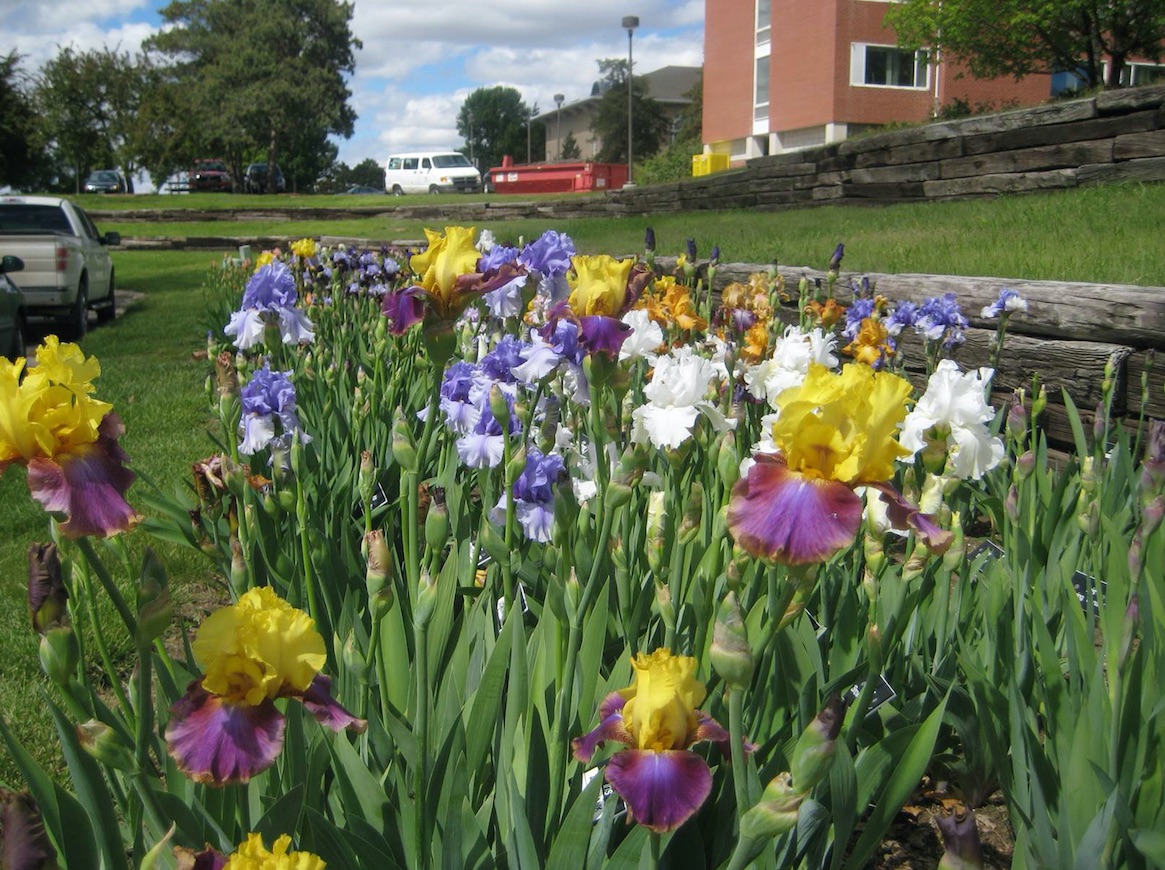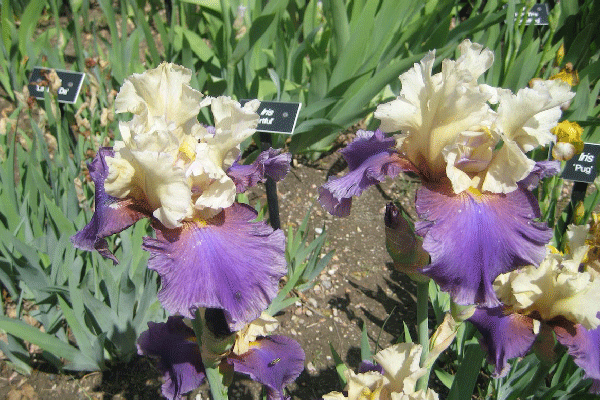Each month Nicole feature a new plant that is well-adapted to Nebraska's challenging growing environment, for you to consider using on your acreage.
April 2017. This is a great time of year for our gardens. Plants are starting to wake up from a long winter dormancy. One of our early blooming perennials in the spring is Iris.
Bearded Iris is a perennial plant that we grow from a rhizome. There are over 200 different species and many varieties of Iris within those species giving many options for color, size, and blooming habit. The flower is comprised of 3 outer flower petals, called falls, and 3 inner flower petals, called standards. The standard petals tend to stand more upright while the fall petals droop downward. This iris is called bearded iris because there is a thick, bushy “beard” on the flower falls. Bearded Iris have fans of bright green, sword-shaped leaves.
Division
Bearded Iris are grown from a rhizome, which is an underground running stem. We plant a piece of a larger rhizome from division to get new plants that look just like the parent plant.
Every 3-5 years, Iris plants need to be dug and divided to prevent a dead plant center and to encourage more vigorous flowering. This is an easy task, just dig the plant and use a sharp spade to cut the rhizomes apart.
Each division should have a fan of leaves and a section of rhizome. Cut the leaves back by two-thirds before replanting.
Replant newly divided plants and share extras with friends and family. It is fun to switch with friends to gain many new colors and sizes and bloom times. Transplanting and dividing Iris should be done in late summer to early fall with July through early August being the best time.

Photo from John Fech, Nebraska Extension Educator.
Iris Species
There are a lot of different varieties of Iris to choose from. The tiny 2-8 inch tall miniature dwarf bearded iris include ‘Bantam’. It is deep red to purple in color with ruffled petals, ‘Scribe’ is white with a blue edge, and ‘Zipper’ is golden yellow with a blue beard.
The next size would be the standard dwarf bearded that grow 8-15 inches tall. They include ‘Bay ruffles’ that is light blue; ‘Starlight’ is cream color with ruffled petals, and ‘Watercolor’ has yellow standard petals and brown fall petals.
Tall Bearded iris are the most popular choice for iris. These include ‘Silverado’ which is blue-white colored, ‘Beverly Sills’ with coral pink flowers, and the dark maroon colored ‘Superstition’.
There are reblooming iris that bloom in spring and then rebloom later in summer. The rebloomers include ‘Champagne Elegance’ with white standard petals and apricot fall petals, ‘Eleanor Roosevelt’ which has deep red-purple blooms, and ‘Sugar Blues’ which is the color of the old-fashioned light violet iris but reblooms over a long season.
There are many other size choices as well as Siberian iris that is similar to Bearded iris, but does not have the beard on the falls. Look through garden catalogs and local nurseries to find the variety that best fits your needs. You might also look for local iris exchange activities where groups get together to divide their iris to obtain new colors for their landscape.

Photo from Kelly Feehan, Nebraska Extension Educator.
Growing Iris
Bearded iris plants prefer to grow in full sun and well drained soils. Often, these plants will grow very well in a rock garden and can be damaged in excess moisture.
Iris plants bloom early in the spring and give us a green, grass-like texture through the rest of the year. Leave the foliage on the plant through the growing season so plants can build sugars through the summer to store in their roots to use for blooming early in the next spring.
Bearded Iris plants are a great addition to many landscapes. Because there are hundreds of varieties to choose from, anyone can find the right size, color, and blooming preference to fit their landscape. So the next time you are looking for a plant for great spring color, choose Iris.

